VTech Laser 200
The VTech Laser 200 was an early 8-bit home computer from 1983, also sold as the Salora Fellow (mainly in Fennoscandia, particularly Finland), the Seltron 200 in Hungary and Italy, the Smart-Alec Jr. by Dynasty Computer Corporation in Dallas, Texas for the USA, the Texet TX8000A (in the United Kingdom), and the Dick Smith VZ 200 (in Australia and New Zealand) and the VTech VZ 200 (in the United States and Canada).
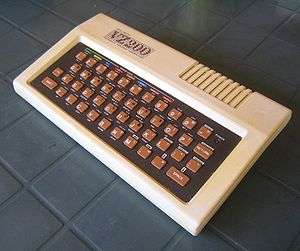 The VTech Laser 210, rebadged as a Dick Smith VZ200 | |
| Manufacturer | Video Technology |
|---|---|
| Type | Personal Computer |
| Release date | November 1983[1] |
| Introductory price | US$99 GB£98 |
| Discontinued | 1985 |
| Units sold | 200,000 in Australia |
| Media | Cassette tape, Disk drive |
| Operating system | BASIC V2.0 |
| CPU | Zilog Z80A clocked at 3.58 MHz |
| Memory | 6-22KB RAM + 2 KB VRAM, 16 KB ROM |
| Display | 32×16 (8 colors), 128×64 graphics (2 background, 3 foreground colors) |
| Graphics | Motorola 6847 video processor |
| Input | 45 key Keyboard |
| Power | 10 volt |
| Dimensions | 29 × 17 × 4cm |
| Mass | 800g |
| Predecessor | VTech Laser 110 |
| Successor | VTech Laser 310 |
Video Technology manufactured calculators and LCD pad game toys (similar to Nintendo Game & Watch) at a rather claustrophobic multi-storey factory in Hong Kong. The VZ200 is a development of an earlier monochrome TRS-80 copy, and is similar to the EACA Color Genie and the Mattel Aquarius.
The machine ran basic games on cassette such as "Hoppy" (a version of Frogger), "Cosmic Rescue" (Scramble), "VZ Invaders" (Space Invaders), "Dawn Patrol" (Chopper) and Moon Patrol. The Laser 200/210 and VZ200 computers were discontinued in 1985 being replaced by the Laser 310 and VZ300 computers.
Release
The VZ200 had little impact in the UK where it sold at a similar price to the 16 kB Sinclair Spectrum and in USA where a Timex TS1000 could be bought for $30. It gained a measurable following in other countries where it was supported by the distributor and where Sinclair Research was too disorganised to have any impact.
It gained some following in Australia and New Zealand, and in some countries in northern continental America and Europe. In Australia it was bought mostly to learn programming; the only other widely available systems being the Commodore 64, whose BASIC is crude and slow, and the much more expensive Amstrad CPC. The Vic-20 and the Commodore 16 more specifically competed with this simple microcomputer.
At its UK launch, Texet claimed that the £98 TX8000-branded version was the cheapest colour home microcomputer on the market. However, this was not enough to ensure its success against the dominant ZX Spectrum and similar machines already on sale.[2]
The "Dick Smith"-badged VZ 200 was more successful in Australia, where it proved popular as a first computer.[3]
An improved version known as the VTech Laser 310, or the Dick Smith VZ 300 featured a full travel keyboard and 8K ROM software based Floppy Disk Controller, was released in 1985 and continued until 1989.[4]
Technical specification
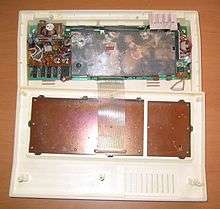
The VZ200 has three circuit boards, the video board and voltage regulator being separate to the main board.
Externally, the VZ200 resembles a cross between the Commodore Vic 20 (whose name it closely resembles) and the Sinclair Spectrum. The VZ200 features the one touch command keys of the Spectrum, but unlike the Sinclair machines, their use was not mandatory.
Internally, the VZ200 is a workalike of the Tandy TRS-80 Model I. The micro uses the same basic architecture, but TRS-80 programs cannot be loaded and only simple TRS-80 BASIC programs can be entered as it has a different memory map and some commands in BASIC are absent and can only be substituted by significant alterations in program algorithms, so it cannot be considered a true clone.
The connections consist of a port for an unregulated DC power supply (the voltage regulator is on the PCB), a stereophonic earphone jack for a cassette recorder, an RF modulated video output, an edge connector which is a printer and disk drive port, an edge connector that is a joystick port, and a composite monitor output (NTSC 60 Hz output in north America, PAL 50 Hz output in the British Commonwealth and continental Europe).
The VZ200 uses a copy of a Zilog Z80 processor (made under licence by NEC) running at 3.58 Mhz (3.54 Mhz on VZ300) and was initially sold with either 4 Kb (Europe) or 6 Kb (in USA), which was increased to 8 KB within weeks of its release. A 16kB expansion unit was available, increasing RAM to 24kB. The VZ300 was initially sold with 18kB of RAM. An 8 kB system consists of 6 kB of RAM, 16 kB of ROM, and 2 kB of video RAM. The memory could be expanded to 24 kB (22 kB memory plus 2 kB video memory). Like the TRS-80, both memory and i/o locations are mapped.

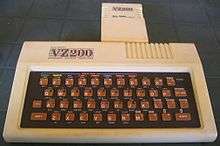
Extended RAM was available above top RAM using the remote offset addressing method available on the Z80 (also known as bank switching). Banks of system memory can be reassigned using an offset above the top RAM. Those banks are then no longer available, so program algorithms cannot be used in extended memory (as the program would "disappear" when extended memory is accessed), so it can only be used for program data.
Video RAM can be increased to access the higher modes of the 6847 since there are video RAM chip select lines on the memory expansion. Remote offset addressing must be used because the video processor cannot address system or internal expansion RAM, externally connected RAM must be used.
BASIC
Like most early micros, the VZ including a built-in BASIC interpreter in ROM, which is used not just for programming, but for accessing the OS, recording programs, and all other operations on the micro.
The VZ200 uses a version of Microsoft Basic II, similar but not identical to Level II Basic on the TRS-80, including useful commands like SET, PRINT@ and IF-THEN-ELSE. Firmware machine code routines are available using the RSX command. The firmware contains a large number of useful routines provided by Zilog, via NEC.
Some TRS-80 BASIC commands, such as RANDOMIZE, ON and the really useful DEF commands (only subroutines can be used for formulae), are not available, so only simple TRS-80 programs can be entered without alteration.
The Basic can use integers, decimals and floating point numbers. Double precision numbers are not available, but can be used by storing the different power position numbers in a string and concatenating the strings.
Video
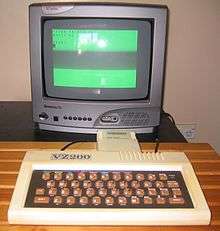
The VZ200 uses the Motorola 6847 video processor, which has a resolution of 256 × 192 pixels made from either 8 × 8 pixel character blocks in a 32 × 24 block screen, or a monochrome bitmapped mode.
As the VZ200 is limited to only 2 kB of video memory since only 4 kB of memory in total was initially available, the screen is limited to only 16 lines down, making the total number of pixels in text mode 256 × 128 pixels. The bitmapped mode is unavailable.
The VZ200 has nine colours, an eight colour palette plus black. The VZ200 has 256 predefined character blocks. Text is only available in upper case. The character blocks cannot be redefined. The screen can use green mode or black mode, the latter using inverse colours.
MODE 0
In mode 0, the background colour can be either dark green or orange.
In mode 0, text uses a black foreground with either background colour. The first 128 character blocks are 64 alpha-numeric characters and their inverses. Text mode 0 is the only mode in which black is available. The latter 128 character blocks consist of a 2×2 pixel block in each possible combination (8), in every of the 8 colour palette for foreground, together with either background colour chosen. Black is not available.
MODE 1
For mode 1, two colour sets are used with each background colour :
- SET 1 -> background : light green - foreground : light green, yellow, blue or red.
- SET 2 -> background : buff [white] - foreground : buff, cyan, magenta or orange.
Text is identical to Mode 0, using either colour set for foreground with each background colour. The difference is that all 2kB of video memory is used, whereas only 512 bytes of video memory is used for Mode 0, and the text cannot be black, which is unavailable in this mode.
The graphics mode has 128×64 addressable points. For each character block, the background colour can be either light green or buff (white), with the foreground any of the four colours in the set. The colours can be used in any combination on the screen, but only one colour set can be used per screen, so screens are limited to five colours at most. Black is not available in this mode. However by using intricate video timing in assembly it is possible to display all eight colours on the screen, as shown in the VZ200 Five Finger Punch demo '2018AD' and Bushy555's demo '8 colours'. Both of these demos technically should not be possible.
Sound output
An internal latch is used for cassette output, to drive the piezoelectric loudspeaker attached to the casing, and to control two signals for the 6847 video processor. The loudspeaker is driven using a push-pull method, alternating the outputs on bits 0 and 5 of the latch. A 2.5 octave range is available.
Models
Laser 310 / VZ-300
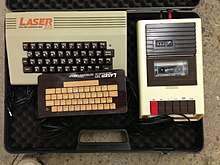
The Laser 310 was released in 1985 throughout parts of Europe, Mainland China and the United States. It was named and sold as the "Dick Smith" VZ 300 throughout Australia and New Zealand. Also based on a Zilog Z80A CPU with a slightly updated 16k ROM version, it was driven by a television colour burst (3.54 MHz) crystal. It came with 16k of RAM for programming, along with the same 2k of Video Ram as that of the Laser 200.
The VZ300 had a small number of physical upgrades, but is completely compatible with the VZ200.
Externally, the rubber keys were replaced with hard plastic capped keys. The case was made with a less brittle type of plastic.
Video Technology used higher capacity memory ICs for the VZ-300, having 18kb of memory (16kb CPU RAM + 2kb video RAM). The system RAM capacity was increased to 16kB, which together with 16kB of expansion RAM, makes a total of 34kB RAM for the system.
The VZ200 16kb RAM expansion could be used, but because of the way the chip select pins were arranged, only 8kB would actually be available. ETI magazine in Australia published an electronic circuit which would enable VZ300 owners to use all 16kB of the VZ200 expansion.
Rare 64k VZ300 unit - There is at least one VZ300 known to exist with 66k of memory (64K RAM + 2K Video), built on the motherboard, built by Video Technology. This unit uses 8x HM4864P-2 8K Static Ram chips instead of the usual 8x 2K memory chips.
Laser 100 / Laser 110
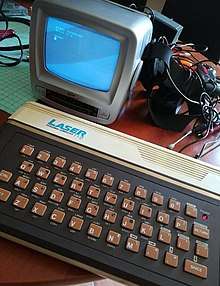
The Laser 100 and 110 were released just prior to the Laser 210 / VZ200. These computers were a near identical clone to that of the TRS-80 Model 1. Both computers were released with the same orange coloured keyboard 'chicklet' style keyboard on a black background.
Both computers also had the same BASIC in ROM, of which, there are at least three versions: 1.0, 1.1 and 1.2. The laser 100 was released with 2K RAM + 2K Video RAM, whilst the laser 110 was released with 4K RAM + 2K Video RAM. Both computers supported colour within the internal language interpreters (BASIC, Assembler), however, the output video from the NTSC and PAL circuitry only supplied black and white signals.
The Laser 100 and 110 computers were never released as a re-badged 'VZ-100'.
Laser 305
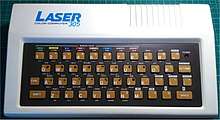
The Laser 305 is an extremely rare computer produced by Video Technology. Essentially it is the Laser 310 motherboard placed inside the Laser 200 keyboard, of which, anyone with these two computers could perform themselves. However, the original release and the reasoning behind VTech releasing this particular configuration, unfortunately, has been lost to history. At the time of writing, there are only two known Laser 305's in existence.
Seltron 200
The Seltron 200 Color Computer is quite unique. It was only sold throughout the two countries of Hungary and Italy and is unique with its own configuration layout of the motherboard; quite different to that of the other family of computers.
The Seltron's motherboard contained the same custom VZ300/Laser310 single packaged GA003 and GA004 chipsets (which replaced discrete VZ200/Laser200-210 components), though the design eliminated the need for the GA008 (clock register and DRAM controller) that is used in the 16Kb VZ300/Laser310. Some speculate that it was Video Technology's attempt at cost reducing the manufacturing process. It was released with the usual 2Kb of video RAM, along with 2Kb of user RAM (Same as the Laser 200), however, the motherboard allowed for further expansion of another 2 KB or 4Kb of RAM. By adding an additional 2x 2 KB user RAM it would bring the Seltron up to the same spec as an "8K" VZ200/Laser210. The Seltron also had the standard 16k ROM, and the motherboard allowed for the option of either a single 16Kb ROM package or 2x 8Kb ROM chip packages.
Only one Seltron is known to still exist today.
Peripherals
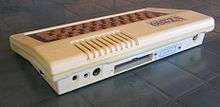

Within a year of the Laser 310's release, an 80k disk drive unit was released on to the market, of which two could be connected to the computer at the same time. A plug-pack cartridge containing the DOS ROM was required to operate the drives. The DOS ROM and diskette drives were backwards compatible with the Laser 200. A number of other VTech designed plug-in peripherals were also available for both the Laser 200 and Laser 310 computers. Among them were joysticks, cassette drive, light pen, printer plotter, 75 baud MODEM, word processor cartridge, and the 16k and 64k extended RAM cartridges. As numbers of users grew, so did the number of home-made kits which were on offer, which included a Speech synthesizer, Texas Instruments SN76489AN programmable sound generator chip, EEPROM programmer, data logger, 300 baud MODEM, full 101 keyboard, and a RTTY Ham radio kit.
Software
With both of their releases in Germany, England, USA, Italy, Australia, New Zealand and a few other countries, commercially based software titles grew and were distributed throughout various outlets in their home county syets store fronts throughout Australia and New Zealand sold many titles, including educational and graphical games, finance programs and various software utility tools, most of which have been found and transferred for the use in the various emulators. Unfortunately, there are a number of known software packages that have simply been lost through the age of time.
Dick Smith Electronics ran a program buying software from local programmers and selling them through their stores for $12 a cassette. Most VZ200 programs were written in Australia, it is the equivalent of the Sinclair ZX-81 in Australia (which was never really available because of production problems in the UK), a system which many early programmers learnt on. The lack of foreign competition tended to encourage local programmers, programmers having little success competing with foreign programs on the most popular system, the Commodore 64.
Emulators
A number of emulators have since been written for these models of computers:
- MESS VZ/Laser emulation by Juergen Buchmueller and Dirk Best
- JEMU (for Java) by Richard Wilson
- JVZ200 (for Windows) by James Tamer
- VZEM (Windows and DOS versions) by Guy Thomason
- Pocket VZ (for the Pocket PC) by Guy Thomason
- Android VZ (for the Android OS) by Guy Thomason
References
- Video Technology LASER 200 / 210 OLD-COMPUTERS.COM Museum
- Bennett, Bill, Texet TX-8000 review Archived 15 May 2004 at the Wayback Machine, Your Computer magazine, April 1983. Retrieved 21 March 2007.
- Dick Smith VZ-200, thepcmuseum.com. Retrieved 21 March 2007.
- Video Technology Laser 310, old-computers.com. Retrieved 21 March 2007.
External links
| Wikimedia Commons has media related to VTech Laser computer. |
- DSVZ200 – VZ200 emulator
- Download page for a number of emulators
- VZEM by Intertek – The official homepage of the VZEM emulator
- JEMU – Java based VZ200 & VZ300 Emulator
- A contemporary review – from Your Computer, April 1983
- Laser Beams in at Just £70 – from Personal Computer News, 18 August 1983
- The VZ200 – Tutorials and Programming
- A VZ200 Wiki – Information
- Clockmeisters VZ/Laser310 page
- German VZ dedication page with 600+ German VZ software titles.
- Bushy's Absolute everything VZ page.
- Steve's VZ page.
- Software
- Intertek's software download page
- Andrew's VZ wiki download page
- Bushy's VZ software download page.